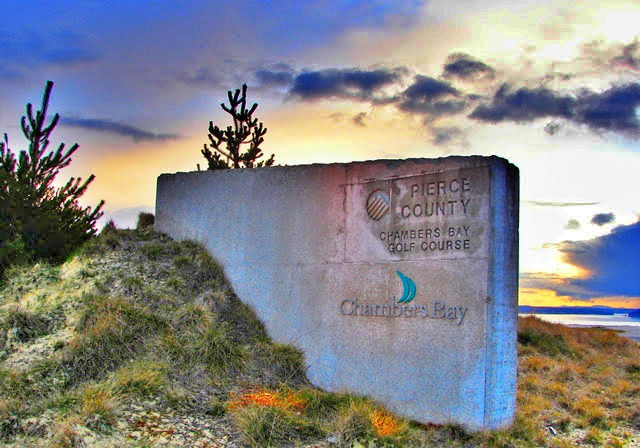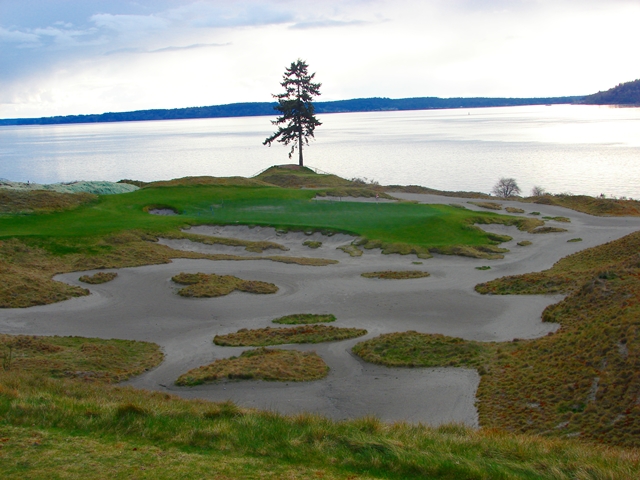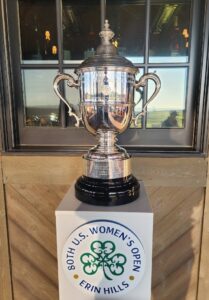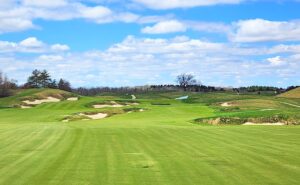Jay Blasi

As a former Project Architect for Robert Trent Jones II design, Jay Blasi was able to bring his own design talents and philosophies to the links project that became known as Chambers Bay. This June Chambers Bay hosts the U.S Open. In our recent Q&A, Blasi talks about what it has been like to be part of the team that will make history – (bringing the first Fescue turf Links setup to an American National Championship).
LinksNation: You grew up in Madison, Wisconsin – How did you get started in golf?
Blasi: My father was a caddie, and he grew up on the south side of Chicago. When he bought his first house after getting married, the first thing he did was he built a putting green in the backyard. So for me I was real lucky, I got to grow up with a putting green in the backyard and was playing on that as a two year old and golf has been part of my life ever since and Madison was big part of that.
LinksNation: You attended the University of Wisconsin and became a landscape architect, afterward you joined RTJ II’s staff, what was that like?
Blasi: It was great, as a kid I knew golf . . . but I had no clue about anything else. I didn’t know the difference between an Oak Tree and a Maple Tree. When I found out that most people who were golf architects had a degree in Landscape architecture that’s what I did. It was a wonderful opportunity at UW because the Landscape Architecture program was very small – there was probably 20 kids in our class and you got to know your professors on a one to one basis, the class itself was always working on projects, so we were always working as teams. I felt very fortunate to have gotten a small school experience in the setting of a major university. All of the culture and resources of a major institution in what felt like a small school hands on experience.
LinksNation: Were you the only student in the class who wanted to pursue golf course design as a career?
Blasi: Yes, and I was fortunate that they allowed me to tailor my curriculum a little bit, so when we were doing a class on a planting design, they would let me do it as a golf hole with landscaping around it. I did a year long independent study project where I designed a second course for the university. My senior thesis was another golf project, so I was the one who did golf that year, but there were others in years prior and years since – usually one student per class.
LinksNation: When you came out did you immediately get hired by Robert Trent Jones Jr., how did that work out?
Blasi: I had reached out to almost everybody, and there wasn’t a single job available, so that was a little scary at that point. I had a buddy in my class who graduated a semester before I did, and he went and was working in a landscape architecture firm, and he said I know you want to work in the golf field, but why don’t you come work for our firm until you can get into golf. About two weeks after I started working with him, I got the call from Jones – saying they were going to hire someone for the first time in however many years, and I was one of three people they wanted to interview. I had to go to my boss of two weeks and ask him for time off to go interview for another job. He couldn’t have been any nicer about it.
LinksNation: (Having been in the field myself for 28 years) I have found that people that are involved in growing, shaping and maintaining landscapes to be among the most interesting and down earth people to talk to. Has this been the case in your experience?
Blasi: Absolutely, particularly the people on the course construction teams . . . but the true heroes are the
superintendents and people who work on the turf care side. They get none of the glory and all of the pain, just great people and fun to be around.
LinksNation: Bravo to that, no better people to talk to than superintendents. I’ve been fortunate to sit down with some of the best in the industry – Matt Shaffer at Merion, Ken Nice at Bandon, Lukus Harvey at PGA Nat’l, and Brad Boyd down at Dorado Beach.
Blasi: Yes, You bring up some great guys, I’ve had a chance to meet Matt and I’ve been around Ken many times now. I love the fact that it is one big community of people who help each other out. For example, when we were working on Chambers Bay, we were researching fescue so we went down and spent time at Bandon Dunes. Their whole team was happy to help and if we ever had an issue we can call them. Superintendents everywhere are one big community that helps each other and that’s pretty refreshing in this day and age.
LinksNation: To take that a step further, during my interview with Matt Shaffer at Merion in 2011, he realized by some of the questions I was asking that I had some kind of background in Agronomy, so in the middle of the Q& A, he turns the tables and starts asking me questions. After our interview he takes me for a tour of the entire property describing each and every modification that will be done to each hole on Merion’s East course. As we finish, he turns to me and says, “How would you like to work with my staff and be a volunteer for us at the 2013 U.S Open?” I was speechless and incredibly appreciative that this man at the top of his profession had the thought and generosity to offer me such an opportunity. It was a great experience being part of that crew, more satisfying than anything I’ve ever done media wise. Who takes their moment, and then turns it around and gives you one of your own? That was an A-ha moment for me. I realized being able to grow turf and manage people is his job, but relationship building takes a special person – Shaffer inspired me that day . . . (but I digress). Lets talk Chambers, a few years back I was at the course opening of Dorado Beach East in Puerto Rico and had dinner with Bruce Charlton (RTJ II lead designer), and he was just raving about Chambers, and impressed to me that I had to get out there and see the place. When I finally did in April 2012, I was really excited to see what you guys had created . Tell me about the what makes Chambers Bay so unique.
Blasi: There are a couple of things, the thing that really jumps off the page for everybody is the scale of the property. Particularly if you start your journey from the clubhouse and look out over the entire course and the Puget Sound. When you actually get down there, you realize that those things you see as specks down there are concrete walls that are 40 feet tall, and those mounds you see lining the fairways are actually dunes that are 55 ft. tall. In terms of great golf, the most common dominator in all great courses around the world is sandy soil. The fact that the site was a former sand and gravel mine, when we had the opportunity to work the site there were these huge stack piles of sand that looked somewhat like dunes, but basically the fact that there was sand in the pit that alone was the key. For any golf architect, that’s like striking oil or finding gold. Couple that with the fact that it’s in the Pacific North- west, and has a climate that would be conducive to Fescue, and being adjacent to water it just became the perfect confluence to try to create a links experience.

LinksNation: We all know it played a little too baked out for the Am in 2010, has the USGA tipped their hand as to how it will be set up for the U.S Open?
Blasi: That U.S Amateur was definitely a trial run, and if you ask Mike Davis, I think he will admit that they probably crossed the limit on one of the days during the stroke play (portion of the championship), but that’s what they had to do to in order to learn. Also, the Amateur was played in August, which gave them all summer long to bake it out. The site isn’t that windy in general, it’s usually no more than a one or two club wind, but there was a day during the Amateur when it was blowing like 20-25 mph . . . with the fairways like concrete, that was really hard. Mike has shared some thoughts about what they learned from the Amateur and how they’ll put that into play. From a firmness standpoint, the golf course is plenty firm, it will only get more firm as we get closer to the championship. It just comes down to working with Josh Lewis (Super at Chambers) and Eric Johnson (Director of Agronomy) on what Mike is looking for.
LinksNation: The biggest challenge for the Agronomy Team at Merion in ’13 was rain, but Shaffer’s little gem held it’s own in the end (with Justin Rose winning at 1 over par). What do you expect to be the biggest challenges for Josh Lewis and the Agronomy Team at Chambers the week of the Open?
Blasi: Great question, one that has not been asked of me till now. As you know, they have been preparing for this week for 7 years! Every week you get closer it only gets heightened, I do think it will probably be different from Merion in that it’s a sandy base and rain wouldn’t really be an issue – the golf course is firm and fast rain or shine. I would think two issues: they have been growing rough for the event (in the beginning there was no rough at Chambers, just super wide fairways), and they’re still trying to figure out the specifics on that. The other is the firmness, perhaps more than any other golf course, that has hosted a major championship – the contours in and around the greens, the kicker slopes and side boards, and the rolls and hollows . . . when it’s playing really firm and fast a ball can land on a spot and end up 70 yards from that spot. Just getting the right firmness and speed is something they’ll continue to work at and dial in to get the magic formula there, because there really is a fine line between making it the ultimate test in golf and letting it get away from you. In order to offer up the greatest test, you really have to push the limits . . . but you really don’t want to go over the edge.


LinksNation: As one of the principal people involved in the actual design of the course, tell me which one or two specific holes at Chambers Bay is your favorite and why?
Blasi: I’m sure you’ve heard this before, but it’s kind of like picking your favorite kid – you like them for different reasons. Some of them you like because they were a challenge to build, others because they’re beautiful, some because of strategic reasons . . . but I will say that my favorite tee shot is on the 14th. If you haven’t seen a photo of that hole before it was built, that is one of things that makes me real proud, not many would have a sense of what was there before – it’s a pretty dramatic transformation. It’s just the ultimate test of hitting a good drive, if you hit a good drive you’re in the fairway in a great spot, if you don’t you’re screwed. A great test. The second shot into the sixth is one that I love as well, and that was probably the biggest change during design. We were very fortunate, Pierce County allowed us a full year to work on the design prior to construction. There were 80 acres of vegetation before we started, so as we drew out the preliminary routing the sixth was going to be a par 3 – we had everything set up and staked. The green was going to be where the fairway landing area is, and after we got some of the clearing done, all of a sudden that little slot in the dunes where six green is presented itself. It was the way the sand mine was left, it was probably the best looking dune on the whole site . . . so we roped it off and kept it as is. We moved 1.4 cubic yards of sand to make the golf course, but there were specific parts where we didn’t really touch anything and the sixth green complex is one where we shaped in the green and added the bunker on the left. I’d be remiss if I didn’t mention 15 as one of my favorites because I love the tree and ended up getting married on that hole.

15th at Chambers bay
LinksNation: I’m so glad the tree was able to saved (after a vandal tried to hack it down with an axe), it is an iconic symbol of the place.
Blasi: Another example of Karma – The vandal came along and tried to knock it down, and ultimately the vandal was the best thing that ever happened to the tree. Every Arborist in the state volunteered their services to come out and help us out, and they said what the vandal did was not a big deal – we can patch that up, but just so you know, this tree is not going to make it as it is because there are some issues in the sub-surface and root structure. They gave us a game plan and mapped out four things we had to do to brighten the outlook for the tree long term. Ultimately, the tree is far better off for having that vandal come along.
LinksNation: What’s next for you and your new company (Blasi Design)?
Blasi: It’s been a fun ride, I started the company in 2012. In 2013 we did a major renovation at Century World in Wisconsin. It was a course that RTJ Jr. had originally designed in the 80’s and we executed the renovation of all tees, greens, bunkers, irrigation system and rerouted five holes. I’m currently working on Santa Ana Country Club in Orange County, California. We’re in the design phase now and will be in construction next year. We’re going to do a complete “Golden Age” style design, what is there now is an outdated 80’s style design. Very excited about that one. Coming down the road is Sharpe Park in San Francisco, we plan on restoring the Mackenzie back to it. Special Thanks to Jay Blasi and Jane Dally.
For more info on Jay Blasi Design: http://www.jayblasi.com/



